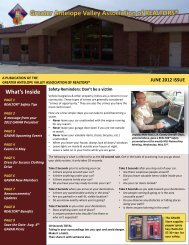May 2013 - Greater Antelope Valley Association of REALTORS
May 2013 - Greater Antelope Valley Association of REALTORS
May 2013 - Greater Antelope Valley Association of REALTORS
- No tags were found...
You also want an ePaper? Increase the reach of your titles
YUMPU automatically turns print PDFs into web optimized ePapers that Google loves.
10 Most Common Violations Found in DRE AuditsThis article obtained directly from the Department <strong>of</strong> Real Estate website1.) B & P Code Section 10148 – Retention <strong>of</strong> RecordsBusiness and Pr<strong>of</strong>essions Code Section 10148(a) states that a real estate broker shall retain for three years copies <strong>of</strong> all listings, deposit slips,canceled checks, trust records, and other documents executed by him or her or obtained by him or her in connection with any transactions for which areal estate license is required. This section requires that, after notice, the books, accounts, and records shall be made available for examination,inspection, and copying by the commissioner or his or her designated representative during regular business hours; and shall, upon the appearance <strong>of</strong>sufficient cause, be subject to audit without further notice, except that the audit shall not be harassing in nature.A broker who fails to keep transaction files, canceled checks or front and back <strong>of</strong> check copies, deposit slips or other records prepared or obtained for aperiod <strong>of</strong> three years may be cited for violation <strong>of</strong> this section. Some brokers cited for violation <strong>of</strong> this section have simply failed to provide records afterreasonable attempts by the Department to examine them. Other brokers cited have lost control <strong>of</strong> or destroyed records that should have beenmaintained. Formal legal action can result from a broker's failure to provide records. You should review the record retention policies for your <strong>of</strong>fice tomake sure you are in compliance with this code section.2.) Regulation 2731 – Use <strong>of</strong> False or Fictitious NameCommissioner's Regulation 2731 states that a licensee shall not use a fictitious name in the conduct <strong>of</strong> any activity for which a license is required underthe Real Estate Law unless the licensee is the holder <strong>of</strong> a license bearing the fictitious name. Brokers should periodically check their license status withthe Department to be sure that their license bears the fictitious name(s) they are using. Many brokers cited for violation <strong>of</strong> this regulation believed thathaving the dba registered with the county was sufficient to allow them to use it in their real estate business. Other brokers who are cited for this violationstate that they had the fictitious name on their license at one time but may have had their license lapse for a brief period <strong>of</strong> time and failed to add theDBA back on to their license.3.) Regulation 2831 – Trust Fund Records To Be MaintainedThis regulation requires the broker to maintain, in columnar form, a record <strong>of</strong> all trust funds received and deposited by the broker. At a minimum, thefollowing information must be indicated in columnar form in chronological order: date funds were received; name <strong>of</strong> payee or payor; amount received;date <strong>of</strong> deposit; amount paid out; check number and date; and the daily running balance <strong>of</strong> the trust account. If any <strong>of</strong> these columns are not present,then there is a violation <strong>of</strong> Regulation 2831. The accurate use <strong>of</strong> DRE form RE 4522 fully complies with this regulation.When we cite this regulation, most <strong>of</strong> the time it is for one or more <strong>of</strong> the following reasons:• The broker did not maintain any trust fund records.• If trust fund records were maintained, they were either not in columnar form or a column (noted above) was missing. We have seen many brokersutilize a standard checkbook as trust fund records. These records do not comply with Regulation 2831.• In some instances, columnar records were maintained by a licensee but he/she was still cited because the items posted were not accurate, e.g.,when posting a check, it was the wrong amount; or, for a deposit, "the amount" was wrong and/or "the date <strong>of</strong> deposit" was the wrong date.• A broker maintaining columnar records can still be cited if a daily running balance is not maintained or is inaccurate. Brokers must always keep adaily running balance <strong>of</strong> the aggregate amount <strong>of</strong> trust funds in their bank accounts.(For trust funds not deposited into a trust account, the columnar record should show the date trust funds were received, the form <strong>of</strong> the trust funds,amount received, description <strong>of</strong> the property, identity <strong>of</strong> the person to whom funds were forwarded, and date <strong>of</strong> disposition. The accurate use <strong>of</strong> DREform RE 4524 fully complies with this part <strong>of</strong> the regulation.)It should be noted that records maintained under an automated data processing system in accordance with generally accepted accounting principlesshould be in compliance as long as they contain the elements previously noted and are maintained in a format that will readily enable tracing andreconciliation in accordance with Reg. 2831.2.4.) Regulation 2831.1 – Separate Record for Each Beneficiary or TransactionThis regulation requires the broker to maintain, in columnar form, a separate record <strong>of</strong> trust funds for each beneficiary or transaction accounting for allfunds which have been deposited into a trust account. This record identifies which beneficiary has funds in the trust account. This record must indicatethe following in chronological order and in columnar form: date <strong>of</strong> deposit, amount <strong>of</strong> deposit, name <strong>of</strong> payee or payor, check number, date and amount,and running balance <strong>of</strong> the separate record after each transaction on any date.This regulation is cited mostly due to one or more <strong>of</strong> the following reasons:• The broker did not maintain separate records for each beneficiary.• Separate records were maintained, but the broker was cited because information was missing.• Separate records were maintained, but the broker was cited because the items posted were not accurate, e.g., when posting a check, it was thewrong amount; or, for a deposit, "the amount" was wrong and/or "the date <strong>of</strong> deposit" was the wrong date.Continued on next page





